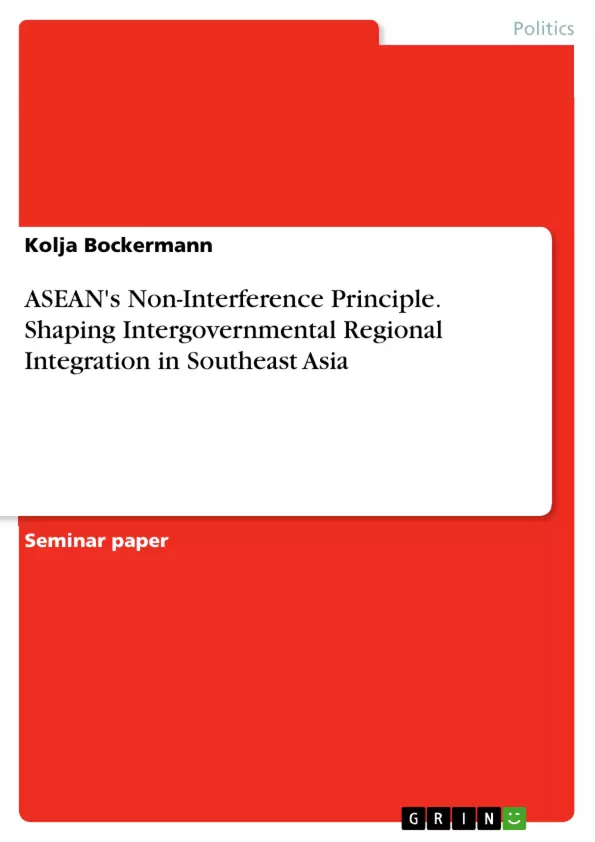In the domain of international relations, regional organizations play a pivotal role in shaping cooperation and integration among member states. The Association of Southeast Asian Nations (ASEAN), established in 1967, stands as a prominent actor in Southeast Asia, distinguished by its non-interference principle in the domestic affairs of member states.
This paper examines the impact of ASEAN's non-interference principle on intergovernmental regional integration in Southeast Asia. In the context of increasing globalization, understanding how ASEAN's commitment to non-interference influences regional collaboration is deemed essential. The principles of non-interference and regional integration are complex, shaped by cultural, sociological, political, and historical factors.
This study aims to explore the intricacies of ASEAN's non-interference doctrine, considering its historical roots, cultural context, and evolving role in regional governance. By unraveling the dynamics between non-interference and regional integration, a nuanced understanding of ASEAN's approach to governance and cooperation is sought.
Throughout this exploration, ASEAN's milestones, achievements, and challenges will be highlighted, emphasizing how the non-interference principle has become a cornerstone of its regional integration efforts. This inquiry aims to provide insights into the complexities of intergovernmental relations within ASEAN, with broader implications for regional organizations navigating similar challenges in the evolving global landscape.
Inhaltsverzeichnis (Table of Contents)
- Introduction
- The Association of Southeast Asian Nations
- ASEAN's Primary Achievement
- ASEAN's Main Aims and Purposes
- ASEAN's Institutional Structure
- The ASEAN Way
- The Principle of Non-Interference
- Non-intervention by International Law
- ASEAN's Regional Integration
- Conclusion
Zielsetzung und Themenschwerpunkte (Objectives and Key Themes)
This paper aims to examine the significance of the non-interference principle within the Association of Southeast Asian Nations (ASEAN) and explain the organization's adherence to this principle. The paper explores the principle's importance in the context of ASEAN's regional integration, considering cultural, sociological, political, and historical factors that influence ASEAN's unique approach to non-interference.
- The role of the non-interference principle in ASEAN's regional integration
- The historical and cultural context influencing ASEAN's approach to non-interference
- The interplay between ASEAN's non-interference policy and international law
- The impact of the non-interference principle on ASEAN's internal dynamics and decision-making
- The relationship between ASEAN's non-interference principle and its regional security objectives
Zusammenfassung der Kapitel (Chapter Summaries)
The introduction provides a context for the paper by discussing the development of regional integration and intergovernmental organizations after the Second World War and the Cold War. It highlights the significance of cross-border cooperation in a globalized world and underscores the variations in policies and structures among intergovernmental organizations. The hypothesis is introduced that the actions of intergovernmental organizations are influenced by the cultural and social heritage of their member states.
Chapter 1 focuses on the Association of Southeast Asian Nations (ASEAN), its history, aims, and institutional structure. It discusses ASEAN's primary achievement in uniting ten Southeast Asian countries and its commitment to regional peace, prosperity, and integration. The chapter also highlights ASEAN's unique approach to regional integration, known as the "ASEAN Way," which emphasizes flexibility, consensus-based decision-making, and the principle of non-interference.
Chapter 2 delves into the principle of non-interference, examining its interpretation both within ASEAN and in international law. It explores the evolution of the non-intervention doctrine in international law and the United Nations Declaration on Principles of International Law concerning Friendly Relations and Cooperation among States. The chapter also discusses the International Court of Justice's interpretation of the non-intervention principle and its significance in international law.
Schlüsselwörter (Keywords)
The key terms and concepts explored in this paper include: non-interference, ASEAN, regional integration, intergovernmental organization, international law, non-intervention, cultural heritage, historical context, ASEAN Way, consensus-based decision-making, regional security, and Southeast Asia.
- Arbeit zitieren
- Kolja Bockermann (Autor:in), 2021, ASEAN's Non-Interference Principle. Shaping Intergovernmental Regional Integration in Southeast Asia, München, GRIN Verlag, https://www.hausarbeiten.de/document/1436615


